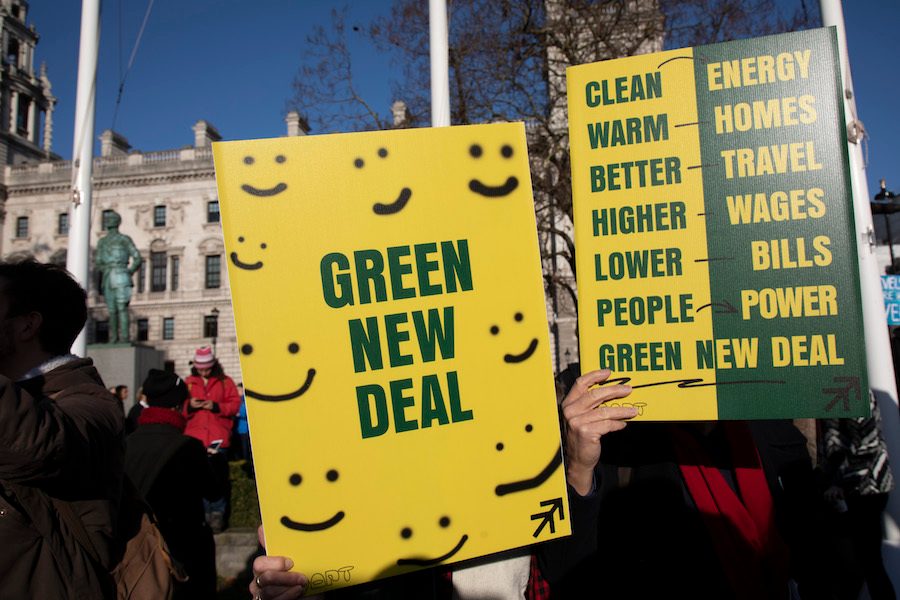For the Green New Deal to Work, It Has to Reject “Growth”
How pursuing unfettered GDP growth makes it impossible to achieve the objectives of the Green New Deal.
Riccardo Mastini, Giorgos Kallis and Jason Hickel

Since 2018, the idea of a Green New Deal has emerged with force in the public debate in the United States thanks to a new-found alliance between climate justice activists and left policymakers. This alliance came to fruition in February 2019 when Rep. Alexandria Ocasio-Cortez (D-N.Y.) and Sen. Ed Markey (D-Mass.) presented House Resolution 109 in the U.S. House of Representatives. Their Green New Deal proposal assigns the State a key role in coordinating national decarbonization, retraining workers to enable a just transition from dirty industries to cleaner industries, implementing a federal job guarantee, and expanding the welfare state to decommodify essential services.
H.Res.109 does not explicitly mention economic growth as a policy objective, but the idea is implicit in its goals to “spur economic development” and “to grow domestic manufacturing.” Besides, three major policy experts associated with the Green New Deal proposal — Justin Talbot Zorn, Ben Beachy and Rhiana Gunn-Wright—argue that boosting working-class wages and upgrading infrastructure is worthwhile because it would strengthen economic growth, therefore making H.Res.109 “fiscally responsible.” Some, like economist Robert Pollin, go even further by framing economic growth not only as a result of the Green New Deal, but also as its engine. Thus, the Green New Deal should be funded with a set share of national GDP. Growth is desirable, then, because higher levels of GDP will correspondingly mean a higher level of investment being channeled into clean-energy projects.
All of this might sound reasonable enough on the face of it, because we are so accustomed to believing that growth is good and necessary. But there’s a problem. Pursuing growth actually works against the objectives of the Green New Deal, and may even make it impossible to achieve.
The key point to grasp is that GDP growth entails increasing total energy demand. While no robust conclusion can be drawn on the direction of causality, studies show that energy and GDP are strongly related. For example, as much as we like to think that growth in rich countries is mostly driven by materially light services (e.g. finance, insurance, digital platforms), the reality is that the fast growth of the information industry has drastically expanded energy consumption. This is a problem, because the more energy we use, the more difficult it is to cover it with renewable sources. We can see this happening in real time: The International Energy Agency finds that, despite significant improvements in energy efficiency and renewable rollout between 2017 and 2018, global energy-related carbon dioxide emissions increased
by 1.5%. Why? Because economic growth is outstripping our gains. The rate of decarbonization would have needed to be about three times faster simply to overcome growth in energy use, and faster still to actually reduce emissions. The importance of both reducing energy demand and increasing efficiency is supported by recent research, which illustrates that, historically, this method has been the pathway for decreasing emissions.
In other words, pursuing GDP growth makes our task much harder than it needs to be. If our goal is to decarbonize the U.S. economy by 2030, we need to be smarter than this. We need to actively reduce total energy use. This is not a matter of opinion. It is a matter of empirics. The Low Energy Demand scenario proposed in the UN Intergovernmental Panel on Climate Change’s 2018 report indicates that, in the absence of speculative negative emissions technologies (such as bio-energy with carbon capture and storage), the only feasible way to achieve our climate goals is to scale down global energy use by 40% over the coming decades, with high-income countries leading the way. The less energy we use, the easier it is to supply it with renewables in the short time we have left.
This requires that we rethink some of our assumptions about how the economy should work. Instead of assuming that all sectors of the economy should grow, all the time, regardless of whether or not we actually need them to, we should think about which sectors we actually want to grow (renewable energy, public healthcare, public transportation), and which sectors are less necessary and can actively be scaled down (SUVs, industrial beef, advertising and so on).
The good news is that the United States doesn’t need more economic growth. We often assume that growth is necessary in order to improve people’s lives. But Spain beats the United States on life expectancy (by a staggering five years) with 56% less GDP per capita. Estonia beats the United States in education with 64% less GDP per capita. Costa Rica beats the United States in health outcomes and well-being indicators with 81% less GDP per capita. And these are not outliers. A total of 41 countries have higher life expectancy than the United States with less GDP per capita. In most cases these high-performers have around 20% to 50% less. For some (Costa Rica, Lebanon, Cuba) it is as much as 80% less.
What explains these countries’ success is that they have robust, universal public healthcare, education, transportation and affordable housing. In other words, provisioning of key social goods is either wholly or partly decommodified, and available to all as a human right. And the empirical record is clear that this is cheaper and more efficient than private, for-profit provisioning (Spain’s public healthcare system costs 80% less than the U.S. system, and delivers significantly better outcomes). This is precisely why Medicare for All should be a tenet of a radical Green New Deal; because it enables people to access the resources they need to live long, flourishing lives, without needing perpetual growth in order to do so.
Many proponents of a growth-based response to climate change — from U.S. President-elect Joe Biden to the European Commission president Ursula von der Leyen—argue that we need growth to reduce inequality. But, in fact, growth generally does exactly the opposite. Over the period of 1980 to 2016, the U.S. economy grew by 151% in real terms. Yet, in the same period none of the growth in per-adult national income went to the bottom 50%, while 32% went to the middle 40%, 68% to the top 10%, and 36% to the top 1%. If we want to reduce inequality, we should target that objective directly, by introducing living wage laws and progressive taxation.
Another common argument is that we need economic growth in order to deliver the innovations necessary for a green transition. But if the objective is to achieve specific kinds of innovations (better solar panels, better railways), it makes more sense to invest in those directly, rather than to grow the whole economy and hope that it somehow magically delivers the results we want. Does it really make sense to grow the beef industry and the plastics industry in order to get more efficient wind turbines?
Many believe that GDP growth will make it easier to pay for the Green New Deal. But, regardless of one’s take on the desirability of economic growth, there are serious concerns about whether growth rates of 2% or 3% per year can be sustained in the long run, given signs that high-income countries are entering a period of secular stagnation (i.e. a permanent, non-cyclical decline in economic growth). And that’s okay, because we have other options. Instead of pursuing more income to finance the Green New Deal, we can redirect existing income more rationally. For instance, we can shift money away from fossil fuel subsidies and arms and toward renewable energy instead. We can also raise funds with progressive taxation on the richest third of U.S. households, with tax rates graded by income within this group. Or we could go for a post-Keynesian approach and rely on federal money creation: Instead of using this power to prop up stock markets and bail out failing corporations, we can use it to finance a Green New Deal.
Progressives have allowed themselves to be pulled into a debate about whether a Green New Deal will be good or bad for growth. The right insists that it will be bad for growth. Understandably, many progressives have stepped in to defend the Green New Deal by saying it will be good for growth. But this is a dangerous move, not only because growth makes our objectives much more difficult to achieve, but also because if the Green New Deal ends up working against growth, then by our own criteria it will have failed and will be vulnerable to attack on these grounds.
It might be a tall order for progressives to call for the end of 40 years of neoliberal hegemony while also calling for the end of 200 years of hegemonic ‘growthism’. But challenge the growth ideology we must, if we want to have a shot at building a fairer society that can thrive within planetary boundaries. In our recent paper, we discuss how the Green New Deal should be understood as a potentially revolutionary program. As scholar and activist Thea Riofrancos argues, it is a contested concept, it is a battlefield, and its meaning and ambition will be the result of the struggle waged by social movements. Therefore, climate justice activists should neither accept it acritically nor reject it, but rather hijack it towards more radical positions. Climate justice activists and left policymakers who want to call for a Green New Deal without growth in the US can find inspiration in the Green New Deal for Europe campaign, which was launched in 2019 by the pan-European political movement DiEM25. This is the first post-growth Green New Deal framework, and stands as a hopeful landmark on the path ahead.




